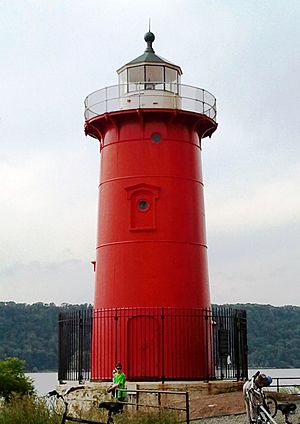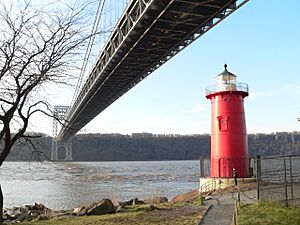Little Red Lighthouse facts for kids
 |
|
| (2012) | |
| Location | Hudson River at Jeffrey's Hook in Fort Washington Park Washington Heights, Manhattan, New York City |
|---|---|
| Coordinates | 40°51′1″N 73°56′49″W / 40.85028°N 73.94694°W |
| Year first constructed | 1889 |
| Year first lit | 1921 (current tower) |
| Deactivated | 1947–2002 |
| Foundation | concrete |
| Construction | cast iron |
| Tower shape | conical |
| Markings / pattern | red with white lantern |
| Height | 40 feet (12 m) |
| Current lens | 12 inches (300 mm) |
| Characteristic | Fl Red, 3s |
| ARLHS number | USA-408 |
| USCG number | 1-37668 |
The Little Red Lighthouse, officially called Jeffrey's Hook Light, is a small lighthouse in New York City. It stands in Fort Washington Park along the Hudson River. You can find it right under the huge George Washington Bridge.
This lighthouse became famous because of a children's book. The book, published in 1942, is called The Little Red Lighthouse and the Great Gray Bridge. It was written by Hildegarde Swift and illustrated by Lynd Ward. The lighthouse sits on a tiny piece of land called Jeffrey's Hook. This spot also supports the base of the bridge's eastern tower. The bridge connects Washington Heights, Manhattan, to Fort Lee, New Jersey.
Contents
History of the Little Red Lighthouse
How the Lighthouse Came to Be
Before the lighthouse, a red pole was used to warn boats on the Hudson River. In 1889, a small light was added to this pole. It helped guide the growing number of boats at night. The land around Jeffrey's Hook became part of Fort Washington Park in 1896.
The lighthouse you see today wasn't always in this spot. It was first built in Sandy Hook, New Jersey, in 1889. It was known as the North Hook Beacon. In 1917, it was no longer needed there. So, in 1921, it was moved and rebuilt at its current location. This was part of a plan to make the Hudson River safer for ships. The lighthouse first used a battery-powered lamp and a fog bell. A part-time keeper operated it.
Saving the Little Red Lighthouse
Construction on the George Washington Bridge began in 1927. The bridge was built right above the lighthouse. When the bridge was finished in 1931, it had its own bright navigation lights. Because of these new lights, the lighthouse was thought to be unnecessary. In 1948, the Coast Guard turned off its light. They planned to sell the lighthouse.
But many people, especially children, loved the lighthouse. They knew it from the famous 1942 book, The Little Red Lighthouse and the Great Gray Bridge. There was a big public outcry to save it. Because of this, the Coast Guard gave the lighthouse to the New York City Department of Parks and Recreation. This happened on July 23, 1951.
The lighthouse was recognized as an important landmark. It was added to the National Register of Historic Places in 1979. It also became a New York City Landmark in 1991. In 2002, the city turned its light back on.
Visiting the Little Red Lighthouse
You can visit the lighthouse by using the Hudson River Greenway. To get there from the north, cross the Henry Hudson Parkway on a footbridge. This footbridge is at West 182nd Street and Riverside Drive. The path from the north is quite steep near the bridge.
From the south, there's another footbridge at West 158th Street. This path is flat. There's also a hidden pedestrian tunnel near 177th Street. It goes under the Henry Hudson Parkway and leads to a dirt path down to the lighthouse.
Sometimes, tours of the lighthouse are offered. These are arranged by the Parks Department's Urban Park Rangers. You can often find tours during the Little Red Lighthouse Festival in late September. Tours also happen on Open House New York day in October.
The Story of the Little Red Lighthouse Book
The children's book, The Little Red Lighthouse and the Great Gray Bridge, came out in 1942. It tells a story about the George Washington Bridge being built next to the small lighthouse. The book teaches that even small things are important.
The story starts by introducing the lighthouse. Every night, a man climbs up to turn on its flashing light. This light warns boats on the busy Hudson River about nearby rocks. When it's foggy, the man also rings the lighthouse's fog bell. The lighthouse feels happy and proud of its important job.
Then, the lighthouse watches as workers build a huge gray bridge next to it. When the bridge is finished, it towers over the lighthouse. The lighthouse starts to feel very small and unimportant. One night, a light begins to flash high up on the bridge's tower. The lighthouse becomes sure that it is no longer needed. Even worse, the man doesn't come to turn on its light. The lighthouse fears it will never shine again.
Meanwhile, a storm starts on the river, and a thick fog rolls in. Boats cannot see the flashing light high on the bridge. Without the lighthouse's light or bell, a "fat black tug" crashes onto the rocks. The bridge then calls to the lighthouse. It explains that its light is for airplanes, not boats. The bridge reassures the lighthouse that it is still needed. It says, "each to his own place."
Finally, the man arrives, rushing and complaining that some boys stole his keys. The lighthouse starts its job again. It warns boats throughout the storm and fog. It is glad it still has important work to do. Even though it knows it is small, it feels very proud.
The book ends by asking readers to visit Riverside Drive in New York City. It encourages them to "see for yourself" the lighthouse next to the bridge. The "great gray bridge" in the story is clearly the George Washington Bridge, even though the book doesn't name it.
Images for kids



